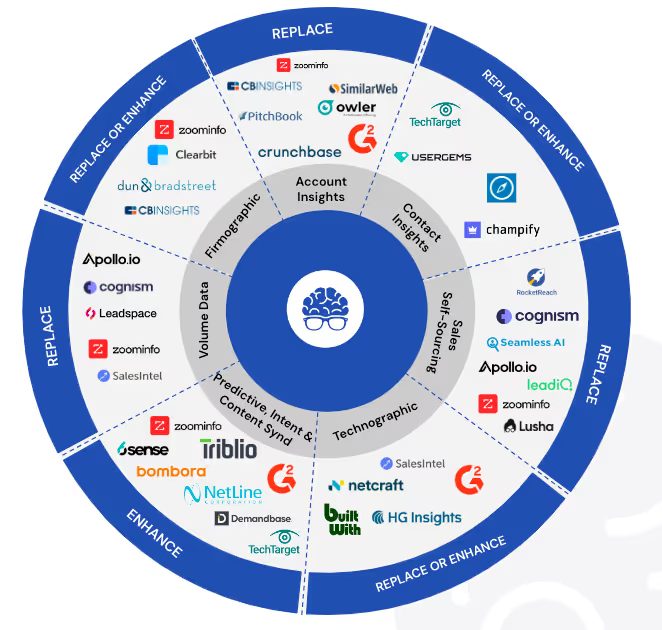If you’re a CMO struggling to hit pipeline numbers, you’re not alone.
And you’re probably not bad at your job.
It’s not your strategy, your team, or even your execution.
It’s the system itself — and the system is broken.
For over a decade, B2B marketing ran on a predictable rhythm. Budgets scaled neatly with revenue. Buyers behaved linearly. Marketing automation stitched together a buyer’s journey that we could track, score, and optimize. It wasn’t perfect, but it worked well enough to build careers, playbooks, and platforms worth billions.
But like any system stretched beyond its design, it cracked — quietly at first, then all at once.
The Budget Squeeze
Let’s start with the money. Because in marketing, as in most systems, if you follow the money, you’ll find the truth.
Gartner’s latest 2025 CMO Spend Survey tells a blunt story: marketing budgets now average just 7.7% of company revenue, flat from last year but down from 11% pre-pandemic — a near-30% structural contraction. That’s not a haircut; it’s an amputation. For a $1 billion company, that’s roughly $33 million in lost marketing firepower.
The drop isn’t anecdotal; it’s systemic. In fact, Gartner notes that in the four years before COVID, marketing spend averaged roughly 11% of revenue, compared to 8.2% in the four years since. The 2024 decline alone — from 9.1% to 7.7% — represented a 15% year-over-year cut. Half of CMOs now report operating with budgets equal to 6% or less of company revenue, and in IT and business services, the decline is catastrophic: budgets have fallen from 9% in 2024 to 5.8% in 2025.
So we have a marketing class being asked to deliver double-digit growth and feed data-hungry revenue teams — with one-third less oxygen in the room.
Meanwhile, the cost of attention — the raw material of marketing — has exploded.
WordStream reports that Google Ads’ average cost-per-lead (CPL) climbed from $66.69 in 2024 to $70.11 in 2025, a 5% increase year-over-year, and nearly 31% higher than two years ago. For B2B tech categories, LinkedIn ad CPLs now routinely exceed $100, with year-over-year inflation of 8%. And according to First Page Sage, the average B2B paid campaign now costs $310 per lead, with some verticals ranging from $40 to $300 just to acquire a single marketing-qualified contact.
Even Google Search Ads — once the most efficient engine in the performance mix — now carry a $116 average cost-per-action in the B2B/tech segment, among the highest of any vertical.
That’s not a tactical problem. It’s a structural failure.
The old B2B marketing economy ran on abundance: abundant channels, abundant cookies, abundant data, abundant budget. When something underperformed, we threw more spend at it. When acquisition costs rose, we raised targets. When buyers got harder to reach, we bought another tool.
That model doesn’t work in a world of scarcity.
The economics have inverted. Every channel — search, social, email, events — is now a high-cost, low-yield ecosystem. Privacy regulations, algorithmic throttling, and audience fatigue have transformed what once were scalable engines into fragile, overgrazed commons.
Finance teams have noticed. Budgets are no longer trust-based; they’re performance-based. Every dollar now competes with headcount, AI investment, or product roadmap for survival.
The result is a silent but pervasive tension inside most marketing orgs: how do you justify your existence when the spreadsheets say the math no longer works?
But here’s the uncomfortable truth — the math can’t work, not when we’re trying to fund yesterday’s playbook with tomorrow’s dollars.
We’re optimizing campaigns for a digital economy that no longer exists.
The clicks are more expensive, the audiences smaller, and the signal-to-noise ratio worse than ever.
This is the paradox of modern marketing:
every channel is measurable, but fewer are meaningful.
Until we rebuild the foundation — how we target, how we measure, and how we allocate capital — no amount of optimization will fix the imbalance.
Because this isn’t about how well you’re spending your budget.
It’s about the fact that the budget itself — and the system that governs it — was built for a world that’s gone.
The Invisible Buyer
The second fracture in the system isn’t financial — it’s behavioral.
Even if you had the budget, you couldn’t see the buyer anymore.
In 2015, marketers could still draw a line between awareness and conversion. We could watch a prospect download an eBook, visit a pricing page, and get routed to sales within a few clicks. But that line has blurred — and then vanished.
Today, the buyer journey has gone dark.
According to 6sense, 70% of the B2B buying journey now happens anonymously — outside any marketing automation platform, CRM, or attribution model. By the time a company shows “intent,” the real decision-makers have already read the reviews, scanned the Reddit threads, tested competitors, and built their short list — all without a single tracked touchpoint.
Gartner adds that 75% of B2B buyers actively avoid speaking with sales until they’re ready to buy, and even then, one-third go completely silent after initial contact (Digital Commerce 360).
So we chase phantoms — MQLs that never convert, “engaged accounts” that never buy, surging intent signals detached from any human being we can actually reach.
It’s not that the buyer disappeared. It’s that they became distributed.
The buying group that once contained three to four stakeholders now spans 6 to 10 people on average, and sometimes up to 16, according to Gartner. They come from different departments, hold competing incentives, and evaluate vendors asynchronously. Most will never fill out a form, never appear in your database, and never be captured by your ABM platform’s scoring logic.
And yet — they’re the ones who decide.
This is the paradox of modern go-to-market: we’ve never had more data, but we’ve never known less about who’s actually buying.
Our martech stacks — designed for visible, linear journeys — can’t model a world where research happens across dark social, private Slack communities, peer calls, WhatsApp threads, and product review sites. The marketing automation systems that promised “buyer visibility” are staring at a stage that’s gone empty.
The consequence is profound: we’re optimizing for what’s trackable, not for what’s true.
Enter Contact-Level Targeting (CLT)
To rebuild visibility, you can’t just add more pixels and tracking scripts. You have to change the level of focus — from the account to the individual.
Contact-Level Targeting (CLT) flips the funnel. Instead of assuming the “account” is the buyer, CLT identifies the humans who make decisions, the teams they sit in, and the technologies or priorities that signal readiness.
It’s not about buying lists — it’s about mapping human behavior in real time.
Which developer is testing new data pipelines?
Which operations manager just switched tools?
Which VP just launched a new initiative tied to your value prop?
These are the micro-moments where pipeline is actually born — and the legacy systems miss every one of them.
Seeing the Invisible
In the absence of cookies and universal tracking, the smartest GTM teams are shifting from detection to inference.
They’re analyzing public web signals, hiring trends, product adoption clues, and social interactions to triangulate who’s in the market. They’re merging verified contact data with opt-in consent frameworks to reach buyers compliantly — and at the moment of actual intent.
This is what it means to see the invisible buyer: not to watch every click, but to reconstruct intent from the traces people leave behind.
And it’s forcing a creative renaissance. Because when you can no longer rely on automation to find your buyer, you have to earn attention with content that feels handcrafted — built for micro-personas, not demographics.
The modern marketer’s job is no longer to score leads. It’s to surface humans.
The Broken Infrastructure
The third crack in the system isn’t about budgets or buyers. It’s about the machinery itself.
For years, marketing automation platforms were the heartbeat of B2B growth. Marketo, Pardot, Eloqua — they were the pipes through which modern marketing flowed. They tracked the journey, scored the lead, passed it to sales, and called it attribution.
But those pipes were laid in a different era — when the web was trackable, cookies were abundant, and privacy was a checkbox in a footer.
That world is gone.
Cookie deprecation, GDPR, CCPA, and a rising wave of privacy frameworks have effectively broken the instrumentation layer of B2B marketing. The very thing automation depended on — deterministic, identifiable behavior — has vanished.
When Apple’s iOS 17 blocked cross-domain tracking, and Chrome began phasing out third-party cookies, most MAPs didn’t evolve. They patched. They raised prices, renamed features, and promised “AI-powered” insights. But underneath the marketing veneer, the architecture didn’t change.
What used to be a living, breathing system of behavioral data is now a static database struggling to see reality.
The cracks show up everywhere:
- Scoring models built on pageviews and downloads no longer predict readiness.
- Attribution dashboards have become works of fiction — optimized for what can be measured, not what matters.
- Lead routing logic fails because contact identity is fragmented across personal emails, multiple devices, and untraceable research behaviors.
It’s like trying to navigate a modern city using a map drawn in 2009. The roads have changed, the landmarks are gone, and the GPS signal keeps cutting out.
And yet, most organizations still use the same tech stack, built around the same assumptions — that buyers are visible, that data is static, that intent can be scored from clicks.
The Great Martech Stagnation
The martech giants — once the engines of innovation — have ossified into tollbooths.
They extract rent, not value.
Subscription costs rise annually, integrations multiply, and complexity metastasizes. Every year, teams pay more to maintain less visibility.
It’s a quiet kind of obsolescence — not a collapse, but a slowing. The technology didn’t break all at once; it just stopped keeping up.
Meanwhile, a new ecosystem has emerged outside the MAP model: platforms built for real-time enrichment, signal capture, and custom orchestration. Tools like LeadGenius, Clay, and a handful of next-generation activation networks aren’t trying to retrofit the old system — they’re rebuilding it from first principles.
Instead of managing a static database, they tap directly into the live web, extracting context from hiring changes, tech adoption, product launches, and buying group shifts.
Instead of one-size-fits-all nurturing, they drive personalized engagement powered by verified, permissioned contact data.
It’s not automation; it’s orchestration — dynamic, adaptive, bespoke.
The Epistemological Crisis
Underneath the technical decay lies something deeper: an epistemological crisis.
We no longer know what we know.
In the old world, marketers could point to a dashboard and say, “Here’s what worked.”
Now those dashboards lie. The data is partial, delayed, or wrong — but it’s visible, so we believe it.
The dangerous result is that strategy has become performative. We optimize for attribution, not reality. We double down on flawed feedback loops because they give us the illusion of control.
Meanwhile, the buyers who matter — the ones discussing you on Slack, Reddit, or internal Teams chats — exist entirely offstage.
So the old infrastructure keeps measuring ghosts, and the new economy keeps rewarding those who can see through the fog.
Rebuilding the System
The future doesn’t belong to the companies with the most automation.
It belongs to those who rebuild the data layer itself — in real time, from verified human signals.
That means replacing the brittle backbone of leased databases with bespoke data orchestration — contact-level, permissioned, and live.
It means shifting from nurture tracks to narrative systems — engines that evolve as the buyer evolves.
It means reimagining “marketing operations” as something closer to “market intelligence.”
Because what broke wasn’t just our tools. It was our epistemology — the way we understand what’s happening in our markets.
And the companies that fix that — that can see clearly again — will own the next decade of B2B growth.
The Tragedy of the Commons
When the digital landscape fragments, marketers compensate by flooding it.
Six million new blog posts are published every day, according to Backlinko.
LinkedIn organic reach has collapsed to 1–2%, half of what it was just a few years ago.
Email? Same story. Open rates down to 27.7%, reply rates hovering near 5% (Infraforge).
It’s the tragedy of the commons, B2B edition.
We found a channel that worked — then overused it until the audience tuned out.
We automated personalization until it felt robotic.
We optimized clickthrough until we forgot about meaning.
The result: the market is flooded with noise that looks like signal.
The Measurement Breakdown
And yet, we’re still measuring success as if it were 2015.
Televerde and Anteriad report that most companies haven’t updated their MQL definitions in over five years.
We’re optimizing toward KPIs that sales doesn’t value and ignoring the metrics that actually correlate with revenue — awareness, preference, credibility.
The irony is that brand has never mattered more, because the system can no longer do the work of trust for us.
What Comes Next: Rebuilding the Foundation
This is where the story turns. Because there is a way forward — but it’s not a patch. It’s a rebuild.
We are entering the era of precision. Not more data — better data.
Not more automation — smarter orchestration.
Here’s what that looks like:
1.Contact-Level Targeting (CLT): The Human Layer
Account-level intent is dead. You can’t market to a spreadsheet.
CLT reintroduces humanity into targeting — mapping the actual people behind the buying committee, identifying who’s researching what, where they sit in the org, and what’s changing in real time.
It’s the difference between shouting into a building and whispering to the right person in the right room.
2. Physical Mail, Real Addresses
In an over-digitized world, the physical world has become the new inbox.
Direct mail, powered by contact-level address verification, is quietly emerging as a high-ROI channel.
When done right — with verified addresses and personalized creative — it’s not “old school.” It’s radical differentiation.
3. Micro-Persona Content
The days of “industry vertical” messaging are over.
A fintech ops manager and a fintech product manager may work at the same company — but they live in entirely different worlds.
Micro-persona content doesn’t just segment; it empathizes. It replaces generic nurture tracks with crafted relevance.
This is the frontier of creative strategy: small-batch storytelling for high-intent humans.
4. New Systems, Built for Reality
Finally, the stack itself needs reinvention.
Systems that pull from real-time web signals, opt-in data, and custom-built datasets — not static data lakes — are the backbone of what’s next.
Because the world doesn’t move quarterly anymore. It moves hourly.
The Balance Sheet
Today’s B2B marketers are being asked to grow pipeline with smaller budgets, higher costs, anonymous buyers, and decaying infrastructure.
That’s not a leadership crisis.
That’s a systems failure.
The next era of B2B growth won’t be defined by who spends the most on ads — but who rebuilds the foundation.
Custom data. Contact-level visibility. Verified connections. Real creative that resonates with micro-personas.
This is the new growth machine.
The question isn’t whether you’re good at marketing.
It’s whether you’re still trying to win a new game with an old playbook.
So — what part of the system is breaking you first?
The budget squeeze, the invisible buyer, or the broken infrastructure?




